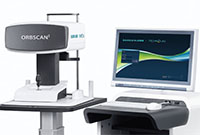The slit lamp is the first available with a 1 mm square aperture and 14-mm variable slit width. Keeler says that the customization available for the Z Series may appeal to doctors with specific or specialized clinical interests, such as intraocular inflammation. For instance, the preset apertures include 0.2, 2, 3, 5 and 9 mm, a 14-mm circle, and a 1-mm square specifically designed for assessing uveitis. It also includes space for additional preset apertures. The slit angle can be adjusted a full 360 degrees. The Z Series includes a shutter trigger on the joystick and camera exposure controls on its base.
For more information, call 1-800-523-5620 or visit keelerusa.com.
Alcon’s NGENUITY 3D Visualization
In an effort to enhance the visualization of the posterior segment for vitreoretinal surgeons, Alcon recently launched its NGENUITY 3-D visualization system (a platform for digitally assisted vitreoretinal surgery).
The new visualization system allows surgeons to operate while looking at a high-definition, 3-D screen, instead of through an operating microscope. Because of the duration of vitrectomy surgeries (ranging anywhere from 30 minutes to three hours), Alcon says the microscope-free viewing design may improve the surgeon’s experience and comfort during the procedure, adding that the system’s high dynamic range camera creates an image with excellent resolution, depth, clarity and contrast. With this new view, the surgeon may now have access to depth perception not previously available on standard monitors.
Surgeons can also magnify the 3-D image while maintaining a wide field of view. The new system provides digital filters that allow surgeons to highlight ocular structures and tissue layers crucial in visualizing the back of the eye. This visualization also minimizes light exposure to the patient’s eye, while still allowing surgeons to operate.
Alcon claims that the NGENUITY system is an excellent teaching and collaborative tool, since the system uses a wide-screen monitor that allows the operating team to see what the surgeon is seeing, in real time.
For more information on Alcon’s NGENUITY 3D system, visit novartis.com.
Bausch + Lomb ORBSCAN3
For surgeons performing the latest refractive procedures, Bausch + Lomb has introduced a new anterior segment analyzer, the ORBSCAN3. The new device provides data regarding corneal biomechanics and stability by examining anterior and posterior astigmatism and optical pachymetry. Using these results, surgeons can make informed choices and identify appropriate candidates for their procedures. The ORBSCAN3 also allows surgeons to provide high-quality refractive care through its ability to assess the size, shape and extent of surface abnormalities.
 |
The ORBSCAN3 features a touch-screen that’s user-friendly, with new software which allows for the analysis of the elevation and curvature on both the anterior and posterior surfaces of the cornea. It is also able to measure full corneal pachymetry, white-to-white distance, anterior chamber depth and angle kappa. It accomplishes all of this through a contact-free analysis of the eye’s anterior segment using slit scanning.
For more information on Bausch + Lomb’s ORBSCAN3, visit bausch.com.
Eschenbach’s Visolux HD Magnifier
In September, with a focus on providing reading comfort to patients with vision loss, Eschenbach released Visolux Digital HD, a 7-in. hand-held video magnifier. The Visolux has magnification capabilities of 2x to 22x, including an HD camera and HDMI/USB connectivity, allowing it to connect to both computers and televisions.
At the higher magnification levels, its dynamic line-scrolling capability allows the user to scroll through the image selection without moving the device. The Visolux also includes 14 color contrast modes, three brightness settings and optional underlineline and blinds function, allowing users to underline or highlight text. Eschenbach says the device’s fold-out stand creates a comfortable and effective reading level, and that the Visolux’s orientation marks, found on the outside of the device, provide guidance for the HD camera’s positioning.
For more information on the Visolux, visit eschenbach.com.
M&S Tech Clinical Trial Suite
In early October, M&S Technologies introduced its clinical trial suite, a customizable set of protocols designed for use in research and clinical trials. In conjunction with the M&S DataRight module, the CTS allows doctors and researchers to retrieve raw data and test results immediately. DataRight’s encrypted data transfer also ensures the security of any clinical trial data, M&S says.
Coming equipped with a full range of hardware options, M&S says that the CTS can be fully customized to fit the specific trial’s needs. Through visual acuity and contrast sensitivity protocols, CTS guides the user through eye charts step by stem and responds to user input.
The module exports the data and test results via an XML or CSV file. These files can then be reviewed for immediate analysis on-site or securely transferred to a reading center.
For more information, visit mstech-eyes.com.



